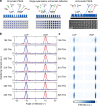Dispersion-engineered spin photonics based on folded-path metasurfaces
- PMID: 40379638
- PMCID: PMC12084559
- DOI: 10.1038/s41377-025-01850-w
Dispersion-engineered spin photonics based on folded-path metasurfaces
Abstract
Spin photonics revolutionizes photonic technology by enabling precise manipulation of photon spin states, with spin-decoupled metasurfaces emerging as pivotal in complex optical field manipulation. Here, we propose a folded-path metasurface concept that enables independent dispersion and phase control of two opposite spin states, effectively overcoming the limitations of spin photonics in achieving broadband decoupling and higher integration levels. This advanced dispersion engineering is achieved by modifying the equivalent length of a folded path, generated by a virtual reflective surface, in contrast to previous methods that depended on effective refractive index control by altering structural geometries. Our approach unlocks previously unattainable capabilities, such as achieving achromatic focusing and achromatic spin Hall effect using the rotational degree of freedom, and generating spatiotemporal vector optical fields with only a single metasurface. This advancement substantially broadens the potential of metasurface-based spin photonics, extending its applications from the spatial domain to the spatiotemporal domain.
© 2025. The Author(s).
Conflict of interest statement
Conflict of interest: The authors declare no competing interests.
Figures





Similar articles
-
Longitudinally continuous varying high-order cylindrical vector fields enabled by spin-decoupled metasurfaces.Nanophotonics. 2024 Mar 4;13(9):1657-1664. doi: 10.1515/nanoph-2024-0008. eCollection 2024 Apr. Nanophotonics. 2024. PMID: 39678177 Free PMC article.
-
High-Efficiency Broadband Achromatic Metadevice for Spin-to-Orbital Angular Momentum Conversion of Light in the Near-Infrared.Small Sci. 2024 Feb 13;4(5):2300273. doi: 10.1002/smsc.202300273. eCollection 2024 May. Small Sci. 2024. PMID: 40213576 Free PMC article.
-
Achromatic metasurfaces by dispersion customization for ultra-broadband acoustic beam engineering.Natl Sci Rev. 2022 Feb 24;9(12):nwac030. doi: 10.1093/nsr/nwac030. eCollection 2022 Dec. Natl Sci Rev. 2022. PMID: 36726640 Free PMC article.
-
Optical Fiber-Integrated Metasurfaces: An Emerging Platform for Multiple Optical Applications.Nanomaterials (Basel). 2022 Feb 26;12(5):793. doi: 10.3390/nano12050793. Nanomaterials (Basel). 2022. PMID: 35269280 Free PMC article. Review.
-
Optical metasurfaces for generating and manipulating optical vortex beams.Nanophotonics. 2022 Jan 10;11(5):941-956. doi: 10.1515/nanoph-2021-0746. eCollection 2022 Feb. Nanophotonics. 2022. PMID: 39634470 Free PMC article. Review.
Cited by
-
Evolution of dispersion-engineered metasurfaces: Debye relaxation and folded path concept.Light Sci Appl. 2025 Jun 24;14(1):223. doi: 10.1038/s41377-025-01890-2. Light Sci Appl. 2025. PMID: 40555712 Free PMC article.
References
-
- Bliokh, K. Y. et al. Spin-orbit interactions of light. Nat. Photonics9, 796–808 (2015).
-
- Cardano, F. & Marrucci, L. Spin-orbit photonics. Nat. Photonics9, 776–778 (2015).
-
- Yin, X. B. et al. Photonic spin hall effect at metasurfaces. Science339, 1405–1407 (2013). - PubMed
-
- Hosten, O. & Kwiat, P. Observation of the spin hall effect of light via weak measurements. Science319, 787–790 (2008). - PubMed
Grants and funding
LinkOut - more resources
Full Text Sources

